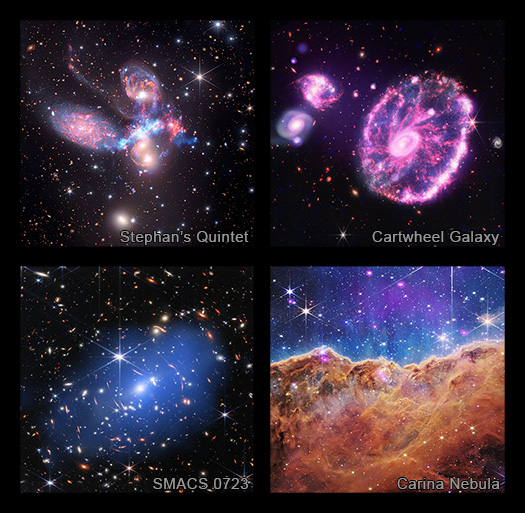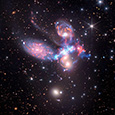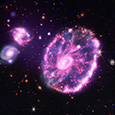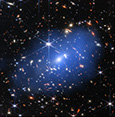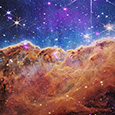Chandra Adds X-ray Vision to Webb Images
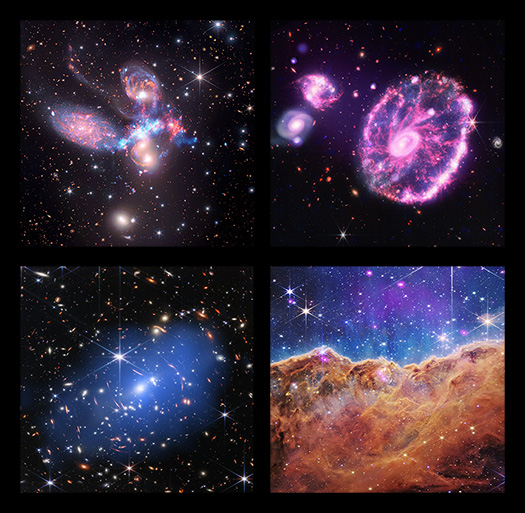
[Upper Left] Stephan's Quintet, [Upper Right] Cartwheel Galaxy,
[Lower Left] SMACS 0723, [Lower Right] The Cosmic Cliffs of the Carina Nebula (NGC 3324)
Credit: X-ray: NASA/CXC/SAO; IR (Spitzer): NASA/JPL-Caltech; IR (Webb): NASA/ESA/CSA/STScI
In the summer of 2022, NASA's James Webb Space Telescope released images from some of its earliest observations with the newly commissioned telescope. Almost instantaneously, these stunning images landed everywhere from the front pages of news outlets to larger-than-life displays in Times Square.
Webb, however, will not pursue its exploration of the universe on its own. It is designed to work in concert with NASA's many other telescopes as well as facilities both in space and on the ground. These new versions of Webb’s first images combine its infrared data with X-rays collected by NASA’s Chandra X-ray Observatory, underscoring how the power of any of these telescopes is only enhanced when joined with others.
Stephan's Quintet:
The four galaxies within Stephan’s Quintet are undergoing an intricate dance choreographed by gravity. (The fifth galaxy, on the left, is an interloping galaxy at a different distance.) The Webb image (red, orange, yellow, green, blue) of this object features never-seen-before details of the results of these interactions, including sweeping tails of gas and bursts of star formation. The Chandra data (light blue) of this system has uncovered a shock wave that heats gas to tens of millions of degrees, as one of the galaxies passes through the others at speeds of around 2 million miles per hour. This new composite also includes infrared data from NASA’s now-retired Spitzer Space Telescope (red, green, blue).
Cartwheel Galaxy:
The Cartwheel galaxy gets its shape from a collision with another smaller galaxy — located outside the field of this image — about 100 million years ago. When this smaller galaxy punched through the Cartwheel, it triggered star formation that appears around an outer ring and elsewhere throughout the galaxy. X-rays seen by Chandra (blue and purple) come from superheated gas, individual exploded stars, and neutron stars and black holes pulling material from companion stars. Webb’s infrared view (red, orange, yellow, green, blue) shows the Cartwheel galaxy plus two smaller companion galaxies — not part of the collision — against a backdrop of many more distant galactic cousins.
SMACS 0723.3–7327
Webb data shows how the galaxy cluster SMACS J0723, located about 4.2 billion light-years away, contains hundreds of individual galaxies. Galaxy clusters, however, contain far more than their galaxies alone. As some of the largest structures in the universe, they are filled with vast reservoirs of superheated gas that is seen only in X-ray light. In this image, the Chandra data (blue) reveals gas with temperatures of tens of millions of degrees, possessing a total mass of about 100 trillion times that of the Sun, several times higher than the mass of all the galaxies in the cluster. Invisible dark matter makes up an even larger fraction of the total mass in the cluster.
NGC 3324, The Cosmic Cliffs of the Carina Nebula
Chandra’s data of the “Cosmic Cliffs” (pink) reveals over a dozen individual X-ray sources. These are mostly stars located in the outer region of a star cluster in the Carina Nebula with ages between 1 and 2 million years old, which is very young in stellar terms. Young stars are much brighter in X-rays than old stars, making X-ray studies an ideal way to distinguish stars in the Carina Nebula from the many stars of different ages from our Milky Way galaxy along our line of sight to the nebula. The diffuse X-ray emission in the top half of the image likely comes from hot gas from the three hottest, most massive stars in the star cluster. They are all outside the field of view of the Webb image. The Webb image uses the following colors: red, orange, yellow, green, cyan, and blue.

